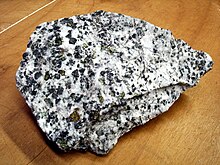Handpiece (geology)

In geology, a handpiece is a rock sample and in mineralogy a mineral step in "hand size", which corresponds to a size between 8.5 cm × 11.5 cm and 10 cm × 15 cm, depending on the available space or purpose also bigger or smaller.
The starting material used is a blank that was collected as a reading stone or a piece of rock detached from the rock. The handpiece is brought into the correct shape (formatted or formatted) using a hammer (usually a geologist's hammer ) and should show the typical properties of the rock from which it was taken. In special cases, one or more sides are sawn and sanded to make the fine structure of the rock more visible. Mineral grades are formatted accordingly so that the individual crystal or aggregate forms come into their own.
A small handpiece was sometimes jokingly or disparagingly referred to as a “women's handpiece”.
In contrast to the handpiece as a scientific object, the artistic aspect is in the foreground with a handstone .
literature
- Walter Schumann: Collecting stones and minerals. Find, prepare, determine . BLV, Vienna, Zurich 1994, ISBN 3-405-14590-2 , p. 146 .
- Martin Kirchmayer: The secrets of the rock world. An introduction to the deformation harmonics of stones . 1st edition. Frieling-Verlag, Berlin 2000, ISBN 3-8280-1162-4 .
Web links
Individual evidence
- ^ Hans Murawski, Wilhelm Meyer: Geological dictionary . 12th, revised and expanded edition. Spektrum Akademischer Verlag, Stuttgart 2010, ISBN 978-3-8274-1810-4 , pp. 70 .
- ↑ Rudolf Graubner: Lexicon of Geology, Minerals and Rocks . Emil Vollmer Verlag GmbH, Munich 1980, ISBN 3-87876-327-1 , p. 156 .
- ^ Salomon Kroonenberg: Waarom de hel naar zwavel stinks . Uitgeverij Atlas, Amsterdam, Antwerp 2011, ISBN 978-90-450-1993-2 , pp. 148 (Dutch, limited preview in Google Book search).
